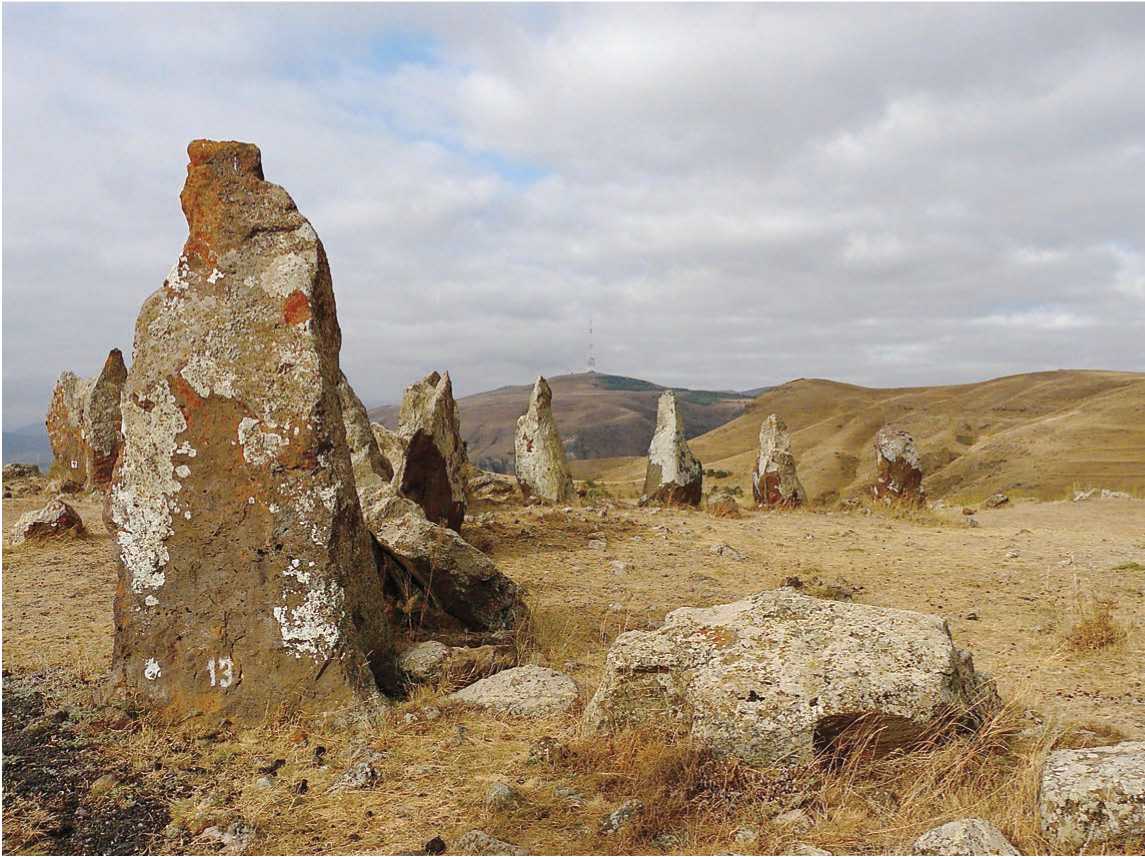In a mountainous region of Armenia near the town of Sisian there is an impressive ritual site and celestial observatory consisting of at least 150 standing stones (Figure 10.74). It dates from the fourth millennium bce or earlier. Another possible ritual center is also located in Israel, known as Rogem Hiri (Rujm al-Hiri in Arabic) some 16 kilometers east of the Sea of Galilee, on a desolate plateau. Thought to date from about 3000 bce, it is a circular construction built of local basalt fieldstones of various sizes. The megalithic tradition was hardly just a European and North African phenomenon. But even these are just the tip of the iceberg. Mounds, rings, and celestial observatories can be found in India, Japan, and Korea, even though they never took root in China, which remained more resolutely attached to an architecture of wood. All in all, the Megalith Era—when viewed globally—lasted an astonishing four thousand years. In India, of the thousands of dolmens and stone circles, only a few have received comprehensive study, making it impossible to reconstruct a larger geopolitical-ritual history of that era.51 The megalith of Asota is certainly one of the finest stone circles of the subcontinent and once comprised about 32 menhirs having an average height of about 3.5 meters; the circle had a diameter of about 17 meters. Two smaller stones, once positioned adjacent to each other, perhaps marked the entrance within the circle. India also has numerous so-called “hero stones” that honor the death of important chiefs. In Japan and Korea megalithic architecture begins to appear around 2000 bce. The dolmen compound known as Jungnim-ri in Korea, placed in a sacred valley, is thought to date from between the seventh and third centuries bce. Some of these have capstones of enormous size. The question naturally arises, how did megalithic ideology move across space and time? The uncanny similarities between tombs in Ireland and those in Korea cannot be just accidental. Did one branch of the tradition move southward into India and another across the northern steppe through Russia—which might explain why it emerged in Korea and not China? Was it linked with the spread of the technologies associated with copper and later iron?
In Japan, the earliest megalithic architecture is not associated with the emergence of farming. The megalithic architecture is still rooted in the world of the First Society. This makes the Japanese examples strikingly different from the European and Asian examples. Initially, there are fewer examples of megalithic tombs, but many examples of stone circles with some organized into square or oval patterns as well. Here too the question is, was this a local development, tied perhaps to some archetypal concept of space, or was it a specific technique that “arrived” at some point and was adopted and integrated into local traditions?
The Oyu stone circle comprises two large circles about 44 meters across and a number of other stone structures. Most of the circles are in the northern part of Japan. But elaborate circles are also to be found at several sites in the more central Chubu region. Some of these structures consist of one large upright stone in the center of a small stone cluster with the stones placed in a radiating pattern. The Komakino circle in northern Japan (2000 bce) is made of three concentric rings that required 2,400 boulders taken up from the Arakawa riverbed 70 meters below the ridge where the stone circle was made. And since the plaza on which the circle was built was sloping, builders had to remove soil from the higher part and transfer it to the lower part. Approximately fifty pit burials are located on the east side of the site and on the slope below the ring there was a natural spring. Since there were over a thousand small Jomon settlements in a 40-kilometer radius, the site probably served as a clan cemetery and multi-functional ritual center.52 A much later Japanese example is the Ishib-utai Tumulus, set up on the spur of a hill and made up of enormous stones. It dates from the early part of the seventh century and is thought to have been constructed for a member of the powerful clan. The capstone weighs about 75 tons, while the chamber underneath, partially dug out of the earth and lined with massive stones, measures 8 by 4 meters and is 5 meters high. It was built on a square 50-meter platform and surrounded by a 12-meter-wide moat. Construction of these types of tombs ceased in Korea in the third century bce and in Japan in the seventh century ce.53
Figure 10.74: Zorats Karer, Armenia. Source: © Rita Willaert (Http://creativecommons. org/ licenses/by/2.0/deed. en)

ENDNOTES
1. See David W Anthony, The Horse, The Wheel and Language: How Bronze-Age Riders from the Eurasian Steppes Shaped the Modern World (Princeton: Princeton University Press, 2007); Pavel M. Dolukhanov, The Early Slavs: Eastern Europe from the Initial Settlement to the Kievan Rus (Philadelphia: Longman, 1996): 94; Alexey Pavlovich Okladnikov, “Inner Asia at the Dawn of History,” in The Cambridge History of Early Inner Asia, trans. Julia Crookenden (Cambridge: Cambridge University Press: 1990): 41-96.
2. Elisabeth Ruttkay, “Das Neolithikum in Niederosterreich—Forschungsbericht der letzten 25 Jahre,” Mitteilungen der Osterreichischen Arbeitsgemeinschaft fur Ur - und Fruhgeschichte 25 (1974/1975): 41-65.
3. Michael Louis Seferiades, “Spondylus and Long-Distance Trade in Prehistoric Europe,” in The Lost World of Old Europe: The Danube Valley, 5000-3500 BC, eds. David W Anthony and Jennifer Chi (Princeton: Princeton University Press, 2010): 183.
4. The following four paragraphs are summarized from John Robb, The Early Mediterranean Village: Agency, Material Culture, and Social Change in Neolithic Italy (Cambridge: Cambridge University Press, 2007), and in particular from Chapter Three, “The Inhabited World.”
5. Ryszard Grygiel and Peter Bogucki, “Early Farmers in North-Central Europe: 1989-1994 Excavations at Oslonki, Poland,” Journal of Field Archaeology 24, no. 2 (Summer 1997): 161-178.
6. Peter Bogucki, Forest Farmers and Stockherders: Early Agriculture and Its Consequences in North-Central Europe (Cambridge: Cambridge University Press, 1988): 64-79.
7. Giuseppe Leuci, “Ancora sulle Opere Neolitiche a Passo de Corvo (Foggia),” Http://digilander. libero. it/Righel40/Leuci1/PL1.htm (accessed January 10, 2012).
8. Santo Tine, Passo di Corvo e la civiltd neolitica del Tavoliere (Genova: Sagep, 1983).
9. Magdalena Midgley, The Origin and Function of the Earthen Long Barrows of Northern Europe, International Series 259 (Oxford: British Archaeological Reports, 1985).
10. Claude Constantin, Daniel Mordant, and Daniel Simonin, La culture de Cerny: Nouvelle economie, nouvelle societe au Neolithique: Actes du colloque international de Nemours, May 9-11, 1994 (Nemours: A. P.R. A.I. F., 1997).
11. Emilia Pasztor, Judit P Barna, and Curt Roslund, “The Orientation of Rondels of the Neolithic Lengyel Culture in Central Europe,” Antiquity 82/318 (December 2008): 910-924.
12. W. Startin, “Linear Pottery Culture Houses: Reconstruction and Manpower,” Proceedings of the Prehistoric Society 44 (1978): 143-159.
13. Jan Joost Assendorp, “Die Bauart der trichterbecherzeitlichen Gebaude von Pennigbuttel, Nie-dersachsen” in Vom Pfostenloch zum Steinzeithaus. Archdologische Forschung und Rekonstruktion jungsteinzeitlicher Haus - und Siedlungsbefunde im nordwestlichen Mitteleuropa, ed. Rudiger Kelm (Heide: Boyens, 2000): 116-125; Markus Honeisen, “Vom Jager zum Bauern: Die neolithische (R) Evolution,” in Die ersten Bauern: Pfahlbaufunde Europas, ed. Markus Honeisen (Zurich: Schweiz-erisches Landesmuseum, 1990): 7-13.
14. Peter Bogucki, Forest Farmers and Stockherders: Early Agriculture and Its Consequences in North-Central Europe (Cambridge: Cambridge University Press, 1988): 64-79.
15. Chris Scarre, “Enclosures and Related Structures in Brittany and Western France,” in Neolithic Enclosures in Atlantic Northwest Europe, eds. Timothy Darvill and Julian Thomas (Oxford: Oxbow Books 2001): 26.
16. Francis Pryor, Britain BC (London: Harper Perennial, 2003): 164-168.
17. See Ludmila Koryakova and Andrej Vladimirovich Epimakhov, The Urals and Western Siberia in the Bronze and Iron Ages (Cambridge: Cambridge University Press, 2007); David W. Anthony et al., “The ‘Kurgan Culture,’ Indo-European Origins, and the Domestication of the Horse: A Reconsideration,” Current Anthropology 27/4 (August-October 1986): 291-313.
18. Marek Zvelebil, Hunters in Transition: Mesolithic Societies of Temperate Eurasia and Their Transition to Farming (Cambridge: Cambridge University Press, 1986).
19. Theron Douglas Price and Anne Birgitte Gebauer, Last Hunters, First Farmers: New Perspectives on the Prehistoric Transition (Santa Fe: School of American Research Press, 1995); Geoff Bailey and Penny Spikins, Mesolithic Europe (Cambridge: Cambridge University Press, 2008); Anthony Weir, Early Ireland: A Field Guide (Belfast: Blackstaff Press, 1980).
20. Marija Gimbutas, The Slavs (London: Thames and Hudson, 1971): 19-20.
21. Marija Gimbutas, “The Beginning of the Bronze Age in Europe and the Indo-Europeans, 35002500 BC,” The Journal of Indo-European Studies 1/2 (1973): 163-214; Evgenii Nikolaevich Chernykh, “Metallurgical provinces of the 5th-2nd Millennia in Eastern Europe in Relation to the Process of Indo-Europeanization,” The Journal of Indo-European Studies 8/3-4 (1980): 317-337.
22. Franco Marzatico, “150 Years of Lake Dwelling Research in Northern Italy,” Living on the Lake in Prehistoric Europe: 150 Years of Lake-Dwelling Research, ed. Francesco Menotti (New York: Rout-ledge, 2004): 88-89.
23. For a site in Spain see: Josep Tarrus, “La Draga (Banyoles, Catalonia): An Early Neolithic Lakeside Village in Mediterranean Europe,” Catalan Historical Review, 1 (2008): 17-33.
24. Helmut Schichtherle, “Lake Dwellings in South-western Germany: History of Research and Contemporary Perspectives,” Living on the Lake in Prehistoric Europe: 150 Years of Lake-Dwelling Research, ed. Francesco Menotti (New York: Routledge, 2004): 30.
25. Barry W Cunliffe, Facing the Ocean: The Atlantic and Its Peoples, 8000 BC-AD 1500 (Oxford: Oxford University Press, 2001), 156; Hilda Roderick Ellis Davidson, Pagan Scandinavia (New York: Frederick A. Praeger, 1967): 29-30; Glyn Daniel, The Megalithic Builders of Western Europe (London: Hutchinson, 1958).
26. Maximilian O. Baldia, “Megalithic Tombs and Interregional Communication,” paper presented at the International Symposium: Megaliths and Social Geography, Falkoping, Sweden, May 13-17, 1994. Paper available at Www. comp-archaeology. org/Falbytxt. htm (accessed June 20, 2011).
27. Mark Edmonds, Ancestral Geographies of the Neolithic: Landscape, Monuments, and Memory (London: Routledge, 1999): 61.
28. Chris Scarre, “A Pattern of Islands: the Neolithic Monuments of North-West Brittany,” European Journal of Archeology 5/1 (April 2002): 24-40.
29. Gabriel Cooney, Landscapes of Neolithic Ireland (London: Routledge, 2000): 35-39; 128-130.
30. Thomas Eric Peet, Rough Stone Monuments and Their Builders (London: Harper & Brothers, 1912): 8-9. Available online at Www. gutenberg. org/files/15590/15590-h/15590-h. htm (accessed August 9, 2011).
31. Andrea Polcaro, “EB I Settlements and Environment in the Wadi - az-Zarqa. Dolmens and Ideology of Death,” Proceedings of the 5th International Congress of the Archaeology of the Ancient Near East, April 2-8 2006, eds. J. M. Cordoba et al. (Madrid: Universidad Autonoma de Madrid, 2008): 31-48.
32. Alastair Service and Jean Bradbery, Megaliths and Their Mysteries: A Guide to the Standing Stones of Europe (New York: Macmillan, 1979): 258-259.
33. Timothy Darvill, Long Barrows of the Cotswolds and Surrounding Areas (Gloucestershire: Tempus, 2004): 43-45.
34. Francis Pryor, Britain BC (London: Harper Perennial, 2003): 155.
35. Jim Grant, Sam Gorin, and Neil Fleming, The Archaeology Coursebook: An Introduction to Themes, Sites, Methods and Skills (London: Routledge, 2005): 156.
36. Richard Bradley, Ritual and Domestic Life in Prehistoric Europe (London: Routledge, 2005): 27.
37. Alistair Oswald, Carolyn Dyer, and Martyn Barber, The Creation of Monuments: Neolithic Causewayed Enclosures in the British Isles (Great Western Village: English Heritage, 2001): 123.
38. A. Whittle and J. Pollard, “The Harmony of Symbols: Wider Meanings,” in The Harmony of Symbols: The Windmill Hill Causewayed Enclosure, Wiltshire. Edited by A. Whittle, J. Pollard, and C. Grigson (Oxford: Oxbow Books, 1999): 381-390.
39. Catherine Stoertz, Ancient Landscapes of the Yorkshire Wolds: Aerial Photographic Transcription and Analysis (Swindon: Royal Commission on the Historical Monuments of England, 1977); D. P. Dymond, “Ritual Monuments at Rudston, East Yorkshire, England,” Proceedings of the Prehistoric Society 32 (1966): 86-95; P. A. Clark, “The Neolithic Ritual Landscape of Rudston,” 2004, www. archaeology. look-here. co. uk/GypseyRace/RudstonNeo/files/RudstonPaper. pdf (accessed June 20, 2011).
40. See David McOmish, “Cursus: Solving a 6000-year-old Puzzle,” British Archaeology 69 (March 2003), Www. britarch. ac. uk/ba/ba69/feat1.shtml (accessed December 10, 2011); Nigel Pennick and Paul Devereux, Lines on the Landscape (London: Hale, 1989).
41. Geraldine Stout and Matthew Stout, Newgrange (Cork: Cork University Press, 2008).
42. Aubrey Burl, Prehistoric Astronomy and Ritual (London: Yale University Press, 1979); Rodney Cas-tleden, The Stonehenge People (London: Routledge, 1987); D. V Clarke and Niall Sharples, “Settlements and Subsistence in the Third Millennium BC” in The Prehistory of Orkney: BC 4000-1000 AD, ed. Colin Renfrew (Edinburgh: Edinburgh University Press, 1985); Timothy Darvill, Prehistoric Britain (London: Yale University Press, 1987).
43. Kathryn Rountree, “Re-inventing Malta’s Neolithic Temples: Contemporary Interpretations and Agendas,” History and Anthropology 13/1 (2002): 31-51.
44. R. Parker and M. Rubinstein, The Cart-ruts on Malta and Gozo (Gozo: Gozo Press, 1984); F. Ventura and T. Tanti, “The Cart Tracks at San Pawl tat - Targa, Naxxar,” Melita Historica 11/3 (1994): 219-240.
45. David A. Barrowclough, “Putting Cult in Context: Ritual, Religion and Cult in Temple Period Malta,” in Cult in Context, Reconsidering Ritual in Archaeology, eds. David A. Barrowclough and Caroline Malone (Oxford: Oxbow Books, 2007): 45-53.
46. Aubrey Burl, The Stone Circles of Britain, Ireland, and Brittany (New Haven: Yale University Press, 2000).
47. Aubrey Burl, From Carnac to Callanish: The Prehistoric Stone Rows and Avenues of Britain, Ireland and Brittany (New Haven: Yale University Press, 1993).
48. R. J. Harrison, The Beaker Folk, (London: Thames and Hudson, 1980); S. Needham, “Transforming Beaker Culture in North-West Europe: Processes of Fusion and Fission,” Proceedings of the Prehistoric Society 71, (2005): 171-217; J. A. Charles, “Where Is AH the Tin?,” Antiquity 49 (1975): 19-25.
49. Robert James Forbes, Studies in Ancient Technology 3 (Leiden: E. J. Brill, 1965): 54-56.
50. George Eogan, Knowth and the Passage Tombs of Ireland (London: Thames & Hudson, 1986).
51. F. Fawcett, “South Indian Stone Circles,” Journal of the Royal Anthropological Institute of Great Britain and Ireland 25 (1896): 373-374.
52. Daisei Kodama, “Komakino Stone Circle and Its Significance for the Study of Jomon Social Structure,” Senri Enthnological Studies 63 (1974): 235-261.
53. The Gochang, Hwasun, and Ganghwa Dolmen Sites in Korea are designated World Heritage sites by UNESCO. World Heritage Convention, “Gochang, Hwasun and Ganghwa Dolmen Sites,” United Nations Education, Scientific and Cultural Organization (UNESCO), Http://whc. unesco. org/pg. cf-m? cid=31&id_site=977 (accessed August 2, 2011). Megaliths were also present in Tibet. See Alexander W Macdonald, “A Note on Tibetan Megaliths,” in The History of Tibet. Volume 1, ed. Alex McKay (Richmond: Routledge, 2003): 909-998.




 World History
World History









